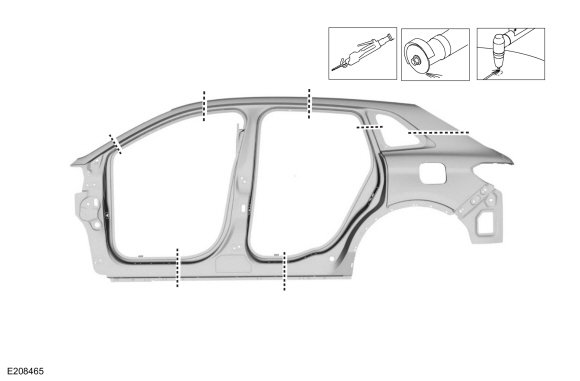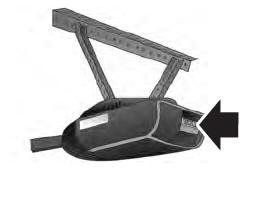Lincoln Nautilus: Body Repairs - Vehicle Specific Information and Tolerance Checks / Body Panel Sectioning. General Procedures
Special Tool(s) / General Equipment
| Resistance Spotwelding Equipment | |
| MIG/MAG Welding Equipment | |
| Spot Weld Drill Bit |
Materials
| Name | Specification |
|---|---|
| Seam Sealer TA-2-B, 3M™ 08308, LORD Fusor® 803DTM |
- |
Repair
NOTICE: Do not begin removal of the vehicle body side until the replacement panel is available for reference.
NOTICE: Do not carry out body side sectioning repairs in areas of door hinge, safety belt or striker anchoring points. Welding within 50 mm (1.96 in) of door hinge or striker locations may compromise structural integrity during a collision.
NOTICE: Sectioning within the door hinge portion of the A-pillar, B-pillar or dog leg portion of the quarter panel is not approved by Ford Motor Company.
NOTE: LH side shown, RH side similar.
-
Only remove as much of the outer body side panel material as necessary using available tools.
Refer to: Joining Techniques (501-25 Body Repairs - General Information, General Procedures).
-
Body side replacement panels are released as 2-part panels.
 |
-
Detrim the vehicle as necessary and remove spot welds from the damaged area.
Use the General Equipment: Spot Weld Drill Bit
-
NOTE: Use resistance spotwelding equipment where possible. This will produce a higher quality repair.
NOTE: When welding overlapping surfaces or substrates, apply a high quality weld-through primer between the surfaces prior to welding.
Where possible, create a lap-joint backer plate using a portion of the old panel. This will create a stronger joint.
Use the General Equipment: Resistance Spotwelding Equipment
Use the General Equipment: MIG/MAG Welding Equipment
-
Rough finish all sectioning joints with a fibre-based
body filler, final finish sectioning joints and plug welds with a
conventional body filler.
-
Properly seal all horizontal joints to prevent moisture
intrusion. Water and moisture migrate toward horizontal joints and
corrosion tends to occur more rapidly in these areas.
Material: Seam Sealer / TA-2-B, 3M™ 08308, LORD Fusor® 803DTM
-
Proceed with the refinishing process using a Ford approved paint system and manufacturers recommendations.
-
Refer to: Corrosion Prevention (501-25 Body Repairs - General Information, General Procedures).
-
Reinstall vehicle trim as necessary.
 Vehicle Specific Body Construction. Description and Operation
Vehicle Specific Body Construction. Description and Operation
For recommended metal repair guidelines and recommendations, refer to the following illustrations and: For additional information, refer to: Specifications (501-25 Body Repairs - General Information, Specifications)...
Other information:
Lincoln Nautilus 2018-2025 Service Manual: Battery and Battery Charging Health and Safety Precautions. Description and Operation
WARNING: Batteries contain sulfuric acid and produce explosive gases. Work in a well-ventilated area. Do not allow the battery to come in contact with flames, sparks or burning substances. Avoid contact with skin, eyes or clothing. Shield eyes when working near the battery to protect against possible splashing of acid solution. In case of acid contact with skin or eyes, flush immed..
Lincoln Nautilus 2018-2025 Owners Manual: Using the Valet Mode. Using the Backup Start Passcode
Using the Valet Mode Press Settings on the touchscreen. Press Valet Mode.Note: Have your Backup Start Passcode completely setup before using Valet Mode. Note: Once the system detects a valid Phone as a Key, the temporary passcode displays in both the touchscreen and mobile app. If the system does not detect a valid Phone as a Key, it prompts you to enter your Backup Start Passcode...
Categories
- Manuals Home
- 1st Generation Nautilus Owners Manual
- 1st Generation Nautilus Service Manual
- Folding the Exterior Mirrors - Vehicles With: Manual Folding Mirrors. Folding the Exterior Mirrors - Vehicles With: Power Folding Mirrors
- Power Outlet - Vehicles With: 110V Power Outlet
- Normal Scheduled Maintenance
- New on site
- Most important about car
Programming the Garage Door Opener to Your Garage Door Opener Motor


